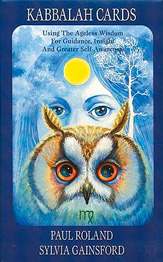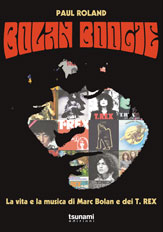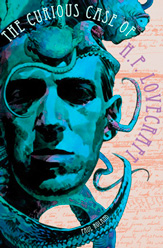NEW Bolan Biography!
Italian rock music specialists Tsunami Edizioni have just published my new Bolan biography, ‘Bolan Boogie’, which looks superb and is very nicely illustrated. Response at the Turin book fair they tell me was very positive and it is hoped that it will be translated into other languages (including English) in the coming year. Here’s a snippet from the preface which explains why I felt the need to write another Bolan book and what Marc’s music has meant to me.
“I owe it all to Marc Bolan.”
I have heard that phrase so many times from musicians and other creative people over the past 35 years that it has made me realise how profoundly an artist can affect those who are moved and inspired by their music. I was one of those adolescents who, in 1972, heard ‘Salamanda Palaganda’, ‘Lofty Skies’ and other early Tyrannosaurus Rex/T.Rex tracks and was awoken to infinite possibilities. The combination of the often unintelligible words, sublime music and the rich tapestry of sound produced by jangling acoustic guitars, exotic percussion, lyrical guitar embellishments and of course that remarkable voice, cast a spell that transported me to somewhere truly magical. I have been trying to recapture that feeling and that moment ever since, through my own music and by re-listening to Bolan and other artists. Several stimulated a similar response, but I always come back to Bolan.
It was Bolan who informed and inspired my first attempts at songwriting and also my first book, a ‘scissors and paste’ biography called ‘Electric Warrior’ which helped me to enter music journalism. I was also very fortunate indeed to have met Marc’s parents who shared their memories of his childhood with me and allowed me to play his guitar (the sunburst Epiphone acoustic he is seen playing in ‘Born To Boogie’) on which I strummed ‘Blades of Battenburg’ as if seeking his blessing on my own efforts. I suspect it may have been the touchstone or talisman that gave me the confidence to pursue my own career in music and it can’t have been a coincidence that soon after I found myself being managed by David Enthoven (of E.G.) and June Bolan. June gave me Marc’s very own acetate of his first recording, ‘The Road I’m On’ and shared some of the secrets behind his early songs. Just prior to that I found myself recording in a studio where Andy Ellison had been working and before you could say ‘Life Is Strange’ he was producing my single ‘Dr Strange’ and a cover of Bolan’s unreleased song ‘Hot George’ and inviting me to write songs for a John’s Children reunion album. None of which would have happened had I not been ‘touched’ by the magic of Marc Bolan.
I hope this book will explain why he has had such a profound effect on me and so many others in the four decades since his tragically early death at the age of 29.
It might also explain why I felt compelled to write three biographies on the same subject. The first, ‘Electric Warrior’, was written in 1979 when I was 19 (and published under a pen name by Omnibus Press in 1982). I had compiled it from dozens of interviews that Marc had given to journalists, so that I could tell his story through his own words, supplemented by comments from musicians and music business people that I had interviewed for extensive articles in ‘Record Mirror’ and ‘Sounds’. Then in 2012, after having written 35 books, I felt it was time to write a more comprehensive biography drawing on the mass of new material that had come to light in the intervening years, with yet more interviews I had conducted with several of Marc’s close friends who had not spoken before and augmented by my insights into his personality which I could not have identified or articulated as effectively back in ’79. But almost as soon as it was published (as ‘Cosmic Dancer’ by Tomahawk Press), I realised that I had written it from a music journalist’s perspective, highlighting the qualities that had made Marc unique, but also being perhaps overly critical in evaluating those later records that had disappointed me. So when Tsunami Edizioni gave me the opportunity to write an entirely new Bolan biography for his Italian fans (and hopefully those in other countries through future foreign language editions) I didn’t hesitate. After all, I owe it all to Marc Bolan.
PR














